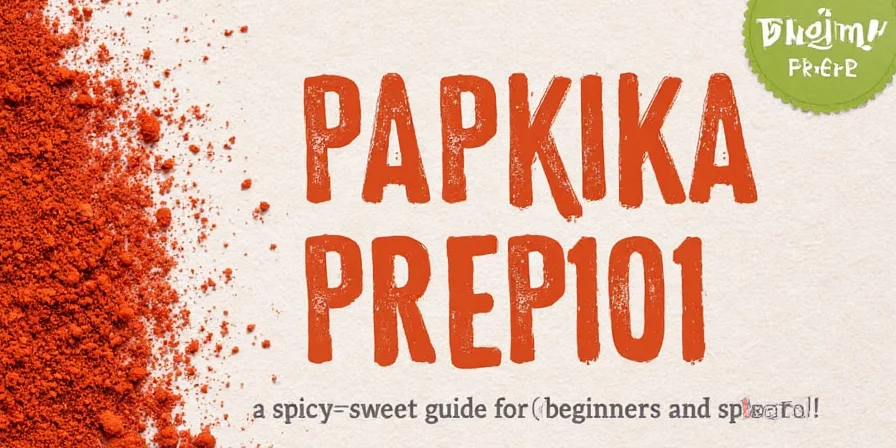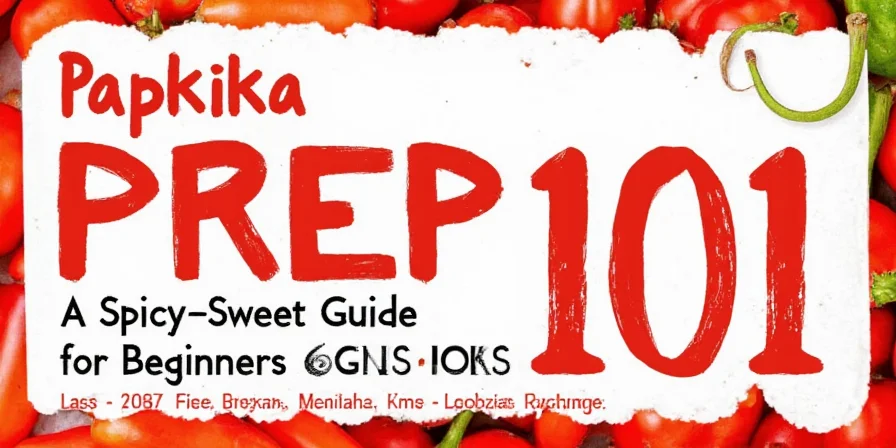Paprika is a ground spice made from dried sweet or hot peppers of the Capsicum annuum family, ranging from mild and sweet to intensely hot and smoky depending on variety and processing method. The vibrant red powder contains carotenoids that provide color and antioxidants, with flavor profiles varying significantly by origin and preparation technique.

Types of Paprika Explained: Sweet, Smoked, Hot & More
Understanding paprika varieties is essential for proper culinary application. Different production methods and pepper varieties create distinct flavor profiles that work best in specific dishes.
| Type | Flavor Profile | Best Culinary Uses | Heat Level (Scoville) |
|---|---|---|---|
| Sweet Hungarian Paprika | Mild, slightly sweet, earthy | Goulash, chicken paprikash, salad dressings | 0-500 |
| Smoked Spanish Paprika (Pimentón) | Rich, deep smokiness, complex | Paella, chorizo, roasted vegetables, bean dishes | 100-2,000 |
| Hot Paprika | Spicy with noticeable heat | Spicy rubs, chili, ethnic dishes requiring heat | 5,000-15,000 |
| Sweet Spanish Paprika | Fruity, mellow, aromatic | Seafood, rice dishes, marinades | 0-100 |
| Bitter Paprika | Strong, pungent, sharp | Traditional Hungarian dishes, meat rubs | 500-1,000 |
How to Use Paprika Properly: Avoid Common Mistakes
Improper handling causes paprika to lose flavor and develop bitterness. Understanding the science behind paprika's behavior prevents these issues:
- Blooming technique: Add paprika to warm (not hot) oil at 140°F (60°C) for 30-60 seconds to release flavor compounds without burning
- Temperature threshold: Paprika degrades at 176°F (80°C), causing color fading and bitter taste
- Storage requirements: Keep in amber glass containers away from light to prevent 300% faster oxidation
Professional Preparation Methods for Maximum Flavor
Whether using store-bought or homemade paprika, these techniques optimize flavor delivery:
Dry Bloom Method for Store-Bought Paprika
- Heat 1 teaspoon paprika in dry skillet over medium-low heat
- Stir constantly for 20-30 seconds until aromatic
- Immediately transfer to recipe or mix with 1 tablespoon oil
- Use within 2 minutes for peak flavor impact

Homemade Paprika Production Guide
For authentic flavor, follow this professional method:
- Select fully ripe red peppers (preferably Hungarian or Spanish varieties)
- Dry at 140°F (60°C) for 8-12 hours until brittle
- Remove seeds and stems before grinding
- Grind in small batches using ceramic grinder
- Store immediately in UV-protected container
Paprika Substitution Guide: When You're Out
Running out of specific paprika types? Use these scientifically informed substitutions:
- Sweet paprika substitute: 1 tsp sweet paprika = 1/2 tsp cayenne + 1/2 tsp sweet red bell pepper powder
- Smoked paprika substitute: 1 tsp smoked paprika = 1/4 tsp chipotle powder + 3/4 tsp sweet paprika (for color)
- Hot paprika substitute: 1 tsp hot paprika = 1/2 tsp cayenne + 1/2 tsp sweet paprika
Optimal Paprika Storage: Science-Backed Methods
Preserve flavor compounds with these evidence-based storage techniques:
- Use amber glass containers (blocks 98% of UV light)
- Fill containers to 90% capacity to minimize oxygen exposure
- Store at 60-65°F (15-18°C) for maximum shelf life
- Add oxygen absorber packets for long-term storage
- Replace every 12-18 months for peak flavor (vs. 24 months commonly recommended)
Recipe-Specific Paprika Recommendations
Match paprika types to dishes for authentic results:
- Spanish paella: Use Pimentón de la Vera (smoked sweet) for authentic flavor
- Hungarian goulash: Combine sweet and hot Hungarian paprika in 3:1 ratio
- Smoked paprika popcorn: Bloom 1 tsp smoked paprika in 2 tbsp melted butter before tossing
- Deviled eggs: Use Hungarian sweet paprika for vibrant color without heat
- Chocolate desserts: Add 1/8 tsp sweet paprika to enhance flavor complexity

Frequently Asked Questions About Paprika
Why does my paprika taste bitter after cooking?
Bitterness occurs when paprika exceeds its thermal degradation point of 176°F (80°C). Carotenoids break down chemically at this temperature, producing bitter compounds. Always bloom paprika in oil under 160°F (70°C) for no longer than 60 seconds.
Can paprika be used in sweet dishes?
Yes, sweet paprika enhances chocolate desserts and fruit compotes with subtle warmth. Its carotenoids improve color in custards while adding complexity without noticeable heat. Use 1/8-1/4 tsp per serving for optimal results.
How to tell if paprika has gone bad?
Fresh paprika should have vibrant color and distinct aroma. If it appears dull, lacks scent, or has musty smell, it's degraded. Perform the warmth test: rub 1/4 tsp between palms - if no aroma develops within 10 seconds, replace it.
Is smoked paprika the same as chipotle powder?
No. Smoked paprika comes from smoked sweet peppers (Pimentón de la Vera), providing deep smokiness with minimal heat (100-2,000 Scoville). Chipotle powder is made from smoked jalapeños (2,500-8,000 Scoville), delivering significant heat and distinct fruitiness.
What's the difference between Hungarian and Spanish paprika?
Hungarian paprika (often labeled "édes nödélyű") is typically sweeter with more floral notes from specific pepper varieties. Spanish paprika (Pimentón) is often smoked over oak, creating deeper, woodsy flavors. Hungarian versions work better in dairy-based sauces, while Spanish smoked excels in meat dishes.
Understanding paprika's chemical properties transforms it from a simple spice into a precision culinary tool. By respecting temperature thresholds, storage requirements, and flavor pairings, you can consistently achieve professional-quality results in everyday cooking.










 浙公网安备
33010002000092号
浙公网安备
33010002000092号 浙B2-20120091-4
浙B2-20120091-4